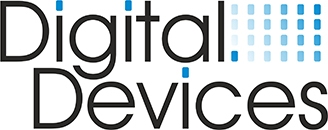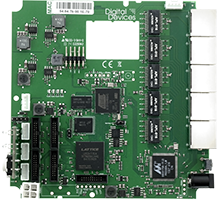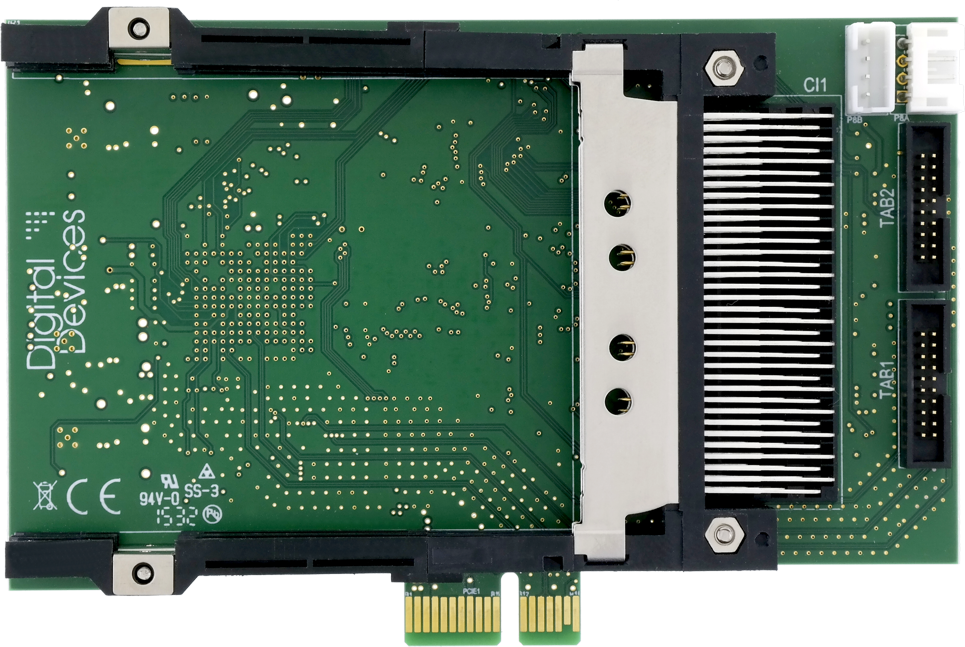4x Multi-Band Tuner
- DVB-S(satellite tuner)
- DVB-S2 (satellite tuner)
- ISDB-S (satellite tuner)
- DVB-C (cable tuner)
- DVB-C2 (cable tuner)
- ISDB-C (cable tuner)
- J.83 (cable tuner)
- DVB-T (terrestrial tuner)
- DVB-T2 (terrestrial tuner)
- ISDB-T (terrestrial tuner)
DVB-S2 Features
- QPSK/8PSK up to 46 MSym with up to 120 Mbit/s (required for UltraHD transponders)
- Sensitivity < 30 dBµV
DVB-T2 Features
- DVB-T2 specification versions: 1.1.1, 1.2.1 and 1.3.1
- DVB-T2 Base Profile
- DVB-T2 Lite(!) Profile
Unicable® SCR/Cenelec EN50494
- Supports up to 8 tuners with just one antenna cable using Unicable®/SCR/CENELEC EN50494 compliant LNB or multi switch.
JESS©/Cenelec EN50607
- Supports up to 32 tuners with just one antenna cable using CENELEC EN50607 compliant LNB or multi switch.
DiSEeqC 2.0 Support
PCIexpress
- Connection via PCIe x1 up to x16 slot
GT-Link Port
- To connect to Octopus NET (Data rate > 1 Gbit)
- Notice: Make use of PCIexpress or GT-Link Port
Support of many TV Applications
- Microsoft Windows® Media Center 7/8, DVBViewer, Media Portal, Gen2VDR, MythTV
Green IT
- Power consumption of ≈ 7 W
- No tantalum capacitors
- No electrolyte capacitors
Supported Operating Systems
- Microsoft Windows® 7/8(.1)/10
- Linux (Kernel 2.6.34 and higher)
Satellite Characteristics
- Up to 46 MSymbols DVB-S2, QPSK, 8PSK
- LNB Power: 4x max. 19 V, 1 A pulse current, 500 mA continuous current
- overcurrent protection, short-circuit protection
- L-Band: 950 MHz to 2150 MHz
- DVB FEC: (Auto Spectral Detection)
- Modulation: QPSK/8PSK
- Full DiSeqC 2.X support
DVB-C Characteristics
- Frequency range: 51 – 858 MHz
- All modulations according to DVB-C specification
- Symbol rates of 0.87 – 6.9 MBaud
- Sensitivity: 47 dbµV (64QAM), 47 dbµV (256QAM)
DVB-C2 Characteristics
- Demodulation
- 16, 64, 256, 1024, 4096 QAM
- 2/3, 3/4, 4/5, 5/6, 8/9, 9/10 Code Rates
- 1/64 and 1/128 Guard Intervals
- 8 MHz and 6 MHz channel bandwidths
- Data Slices Types 1 & 2 supported
- Data Slice width up to 7.61 MHz
- Stream processor for automatic common PLP and data-PLP combination
- Notch Support
- Narrowband and broadband notches
- Reception of narrow channels down to 2 MHz between broadband notches
- Time interleaving modes 4, 8 symbols and ‚best fit‘
DVB-T/T2 Characteristics
- Frequency range: 49 – 861 MHz, 2k & 8k OFDM
- All modulations according to DVB-T and DVB-T2 specification
- Sensitivity: -83,0 dBm at 16-QAM&3/4
ISDB-T Characteristics
- Conforms to ARIB STD-B31
- 6 MHz, 7 MHz and 8 MHz BW support
- Excellent phase noise resistance
- Excellent multipath equalization performance
- Automatic detection of mode/guard interval lengths
- EWS (Emergency Warning System) flag output
Standard Connectors
- PCI Express
- Sat-F connector (support possible required, requires power supply to LNB)
- IEC connector (Input)
- 20-pin socket for flat-ribbon cable to connect to Octopus NET
Unicable Compliant
- SCR/Cenelec EN 50494 (Unicable®)
- CENELEC EN50607
Green IT
- RoHS compliant
- WEEE DE 99353762
Power Consumption
- DVB-T2: 8.6 W (worst case -80 dBm QAM256 7/8)
- DVB-C: 7 W
- Notice: active cooling required, passive cooling is not enough,
a slight air flow in the PC is sufficient
Supported Operating Systems
- Linux (Kernel 2.6.34 and higher)
- Microsoft Windows® 7 (32/64 Bit) (incl. Windows® Media Center)
- Microsoft Windows® 8 (32/64 Bit) (incl. Windows® Media Center)
- Microsoft Windows® 10 (32/64 Bit)
System Requirements
- Dual Core Intel® or AMD® CPU
- 512 MB RAM
- 1x PCIe slot (x1 up to x16)
Dimensions
- L 104 mm, W 111 mm, H 15 mm
Octopus NET Rack
The Octopus NET Rack can be connected to Max M4, Max SX8, Max A8i or Max S8 via the GT-Link Port.
More details...
| DVB-S2/S2X Features |
Max SX8 |
Max SX8 Basic |
Max S8 |
Max M4 |
Cine S2 V7A |
| Short Frames | |||||
| Long Frames | |||||
| ACM/VCM | |||||
| MIS | |||||
| Annex M | |||||
| Channel Bonding (S2X) | |||||
| QPSK 1/4,1/3,2/5 | |||||
| QPSK 1/2, 3/5, 2/3, 3/4, 4/5, 8/9, 8/10 | |||||
| QPSK 13/45, 9/20, 11/20 | |||||
| QPSK 11/45, 4/15, 14/45, 7/15, 8/15, 32/45 | |||||
| 8PSK 3/5, 2/3, 3/4, 5/6, 8/9, 9/10 | |||||
| 8PSK 23/36, 25/36, 13/18 | |||||
| 8PSK 7/15, 8/15, 26/45, 32/45 | |||||
| 8APSK-L 5/9, 26/45 | |||||
| 16APSK 2/3, 3/4, 5/6, 8/9, 9/10 | 3 | ||||
| 16APSK 26/45, 3/5, 28/45, 23/36, 13/18, 7/9, 77/90 | |||||
| 16APSK 7/15, 8/15, 26/45, 3/5, 32/45 | |||||
| 16APSK-L 5/9, 8/15, 1/2, 3/5, 2/3 | |||||
| 32APSK 3/4, 4/5, 5/6, 8/9, 9/10 | 3 | ||||
| 32APSK 32/45, 11/15, 7/9 | |||||
| 32APSK 2/3, 32/45 | |||||
| 32APSK-L 2/3 | |||||
| 64APSK 11/15, 7/9, 4/5, 5/6 | |||||
| 64APSK-L 32/45 | |||||
| 128APSK 3/4, 7/9 | |||||
| 256APSK 32/45, 3/4 | |||||
| 256APSK-L 29/45, 2/3, 31/45, 11/15 | |||||
| VL-SNR | |||||
| Maximum Symbolrates (MSymbols/s) |
Max SX8 |
Max SX8 Basic |
Max S8 |
Max M4 |
Cine S2 V7A |
| QPSK | ~954 | 64.54 | 45 | 46 | 67.5 |
| 8PSK/8APSK | 864 | 64.54 | 45 | 46 | 67.5/455 |
| 16APSK | 64.54 | 34.53 | 67.5/33.755 | ||
| 32APSK | 51.64 | 27.53 | 54/275 | ||
| 64APSK | 434 | ||||
| 128APSK | 36.854 | ||||
| 256APSK | 32.254 | ||||
| Annex M | 500 | ||||
| Card Features | |||||
| Demodulators/Channels | 8 | 8 | 8 | 4 | 2 |
| Inputs | 4 | 4 | 4 | 4 | 2 |
| BBFrame Output |
3 16APSK, 32APSK possible but 4dB loss of performance
4 Maximum DVB-S2/S2X LDPC bitrate is limited to 720 Mbit/s. This bitrate is defined as symbolrate * bits/symbol, i.e. 8PSK 30 Msymbols = 90 Mbit/s. The used bitrate is dynamically allocated by the driver. DVB-S channels don't contribute to the limit.
5 Single/dual demod usage.




